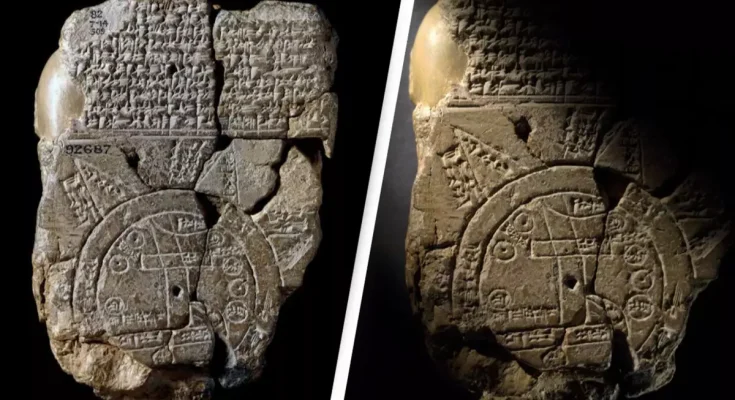The map could help identify the location of the remnants of ‘Noah’s ark’.
Scientists have deciphered the world’s most ancient map that could help locate the remnants of ‘Noah’s ark’ in ancient Mesopotamia.
Housed at the British Museum, a Babylonian artefact known as Imago Mundi (Latin for ‘Image of the World’) features a map of Mesopotamia — present-day Iraq — enclosed by two circles representing the bitter river.
The tablet provided contemporary travellers with a set of directions on its reverse.
Discovered in 1882 by renowned archaeologist Hormuzd Rassam in Sippar, the map was written and inscribed on clay in Mesopotamia around 2,900 years ago.
The artefact was damaged, but used to include eight triangles surrounding the central circle and indicating mountains.

The Imago Mundi is a Babylonian map on display at the British Museum. (YouTube/The British Museum)
Assyriologist Dr Irving Finkel, who works for the Department of the Middle East in the British Museum and specialises in cuneiform inscriptions, and a gifted student of his, Edith Horsley, joined a fragment of the tablet to the map back in 1995, with this missing piece helping researchers to uncover a biblical reference.
Among the keys to read the map, one portion says that travellers must pass through ‘seven leagues… [to] see something that is thick as a parsiktu-vessel’.
In a gripping YouTube video, Dr Finkel said that ‘parsiktu’ is a crucial term in his field.
The word appeared on another ancient Babylonian tablet, specifically in connection to the size of a boat needed to survive the Great Flood.
“This parsiktu measurement, is something to an Assyriologist which makes their ears prick, and the fact is it’s only once otherwise known from cuneiform tablets and it’s rather an interesting cuneiform tablet too,” said Dr Finkel.
“Because it is the description of the Ark which was built, theoretically, by the Babylonian version of Noah.”
It seems that when following the instruction of the Imago Mundi, researchers would find a path to ‘Urartu’, where an ancient Mesopotamian poem claims a man and his family landed an ark to preserve life amid the flood.

Dr Irving Finkel and his student Edith Horsley managed to find a piece to join to the map in 1995. (YouTube/The British Museum)
The location is the Assyrian equivalent to ‘Ararat,’ which is the Hebrew word for the mountain where Noah crashed the Biblical vessel.
“It shows that the story was the same, and of course that one led to the other but also, that from the Babylonian point of view, this was a matter of fact thing,” Dr Finkel said. “That if you did go on this journey you would see the remnants of this historic boat.”
He continued: “For the first time, we can pronounce with authority, that if we were an ancient Babylonian, we would know where to go to see the remnants of that wonderful boat.”‘



